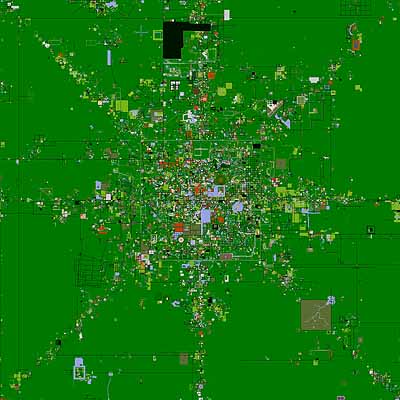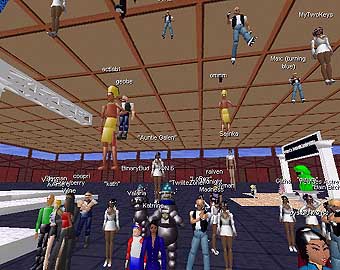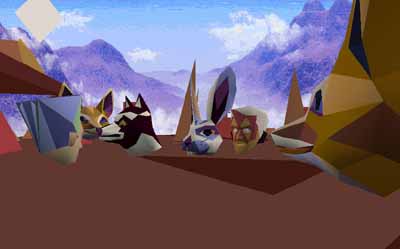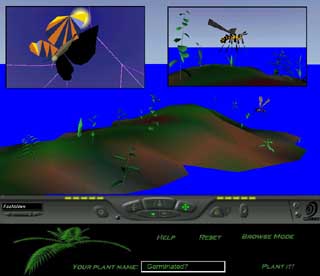Proposed for SIGGRAPH 99, Los Angeles Convention Center
August 8-13, 1999
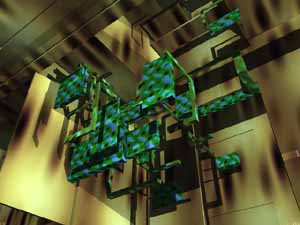
A Generative Virtual World.
Evolved virtual architectures by Eric Bucci, University of Texas at Austin.
Course Proposal
Name, title, affiliation, and a short biography
Michael Heim: Graduate Faculty, Art Center College of Design, Pasadena, California, author "Virtual Realism" (Oxford U. Press, 1998), "The Metaphysics of Virtual Reality" (Oxford U. Press, 1993), "Electric Language" (Yale U. Press, 1999). Michael recently presented the "Deep Cyberspace" course at ACCD which involved a number of virtually present students and instructors
Bruce Damer: President and CEO, DigitalSpace Corporation, Director, Contact Consortium, author "Avatars" (Peachpit Press, 1998), "Virtual Worlds" (Perseus Press, 1998). Bruce Co-directs a 35 institution research and development consortium bringing virtual worlds to the net. He is a visiting scholar at the University of Washington HIT Lab and a Silicon Graphics Vanguard of Visual Computing.
Marcos Novak: U.T. Austin, Advanced Design Research Program, School of Architecture, and UCLA, Architecture and Urban Design; author "Liquid Architecture" (Cyberspace: First Steps, MIT Press, 1990). Marcos is a transarchitect, artist, and theorist investigating the tectonics of technologically augmented space.
Michael Powers: President of Flatland Online, creator of 3D virtual worlds platforms and author "How to Program a Virtual Community" (Ziff-Davis / Macmillan, 1997). Michael has taught well regarded courses on virtual communities at San Francisco State University and has a technology background with Xerox, Digital and Kaleida Labs.
Expanded Statement:
Virtual Reality has moved from high-end, expensive display technologies to real-time, 3-D worlds on the Internet which operate at modem speeds. The migration of virtual communities to colonize these worlds brings new challenges for interactive graphics, social psychology, and the aesthetics of world design. This course gives an overview of online world technologies and applications, detailed explanations of how to develop and foster successful worlds, and a discussion of the degrees of realism that are desirable in virtual worlds. We will focus on worlds in which users can build their own spaces and create their own community structures.
List of prerequisites
This course is intended for graphic designers, online artists, virtual community developers, and engineers wanting to understand the psychology and aesthetics of virtual worlds and to deploy real-time person to person systems. This is an beginner to intermediate course presupposing a familiarity with the Internet and some experience with 3-D graphics.
List of topics
1) 3D virtual world creation and net delivery techologies, 2) avatar, bot, agent and biote design, 3) psychological impact of avatars, interface affordances and world aesthetics on inhabiting virtual communities, 4) use of virtual worlds in learning, play, collaboration, science and the arts
A large scale event virtual world
Avatars crowd the scene at the Contact Consortium Avatars98 cyberconference, Nov 21, 1998
Course syllabus.
As a team we will move through these topics in the following broad areas:
The history of the medium and definition of terms
- What is an online virtual world?
- The idea of virtual reality (high-end immersion) versus cognitive immersion in virtual worlds
- Origins of textual virtual communities: MUDs, the WELL, IRC, Web communities
- Convergence in 3D with virtual communities
- The nature of avatar communities
- The attraction of virtual worlds versus virtual reality
3D virtual world creation and net delivery techologies
- A tour of various world designs on several platforms
- Streaming geometry and voice
- Abstraction and art stores
- Serverless or hubbed worlds
- Citizen authorization, identity management
- Communications and community interface affordances
- Understanding the client / server structure
- Modeling for bandwidth
World, avatar, bot, agent and biote design
- The basic components of world design
- The practical side of Authoring Building (hosting)
- Avatar creation technologies and design sensibilities (do they always have to be humanoid?)
- Architectural paradigms for virtual space
- The role of artificial life in virtual worlds
- Sounds and textures and animated or generated behaviors in cyberspace
- Bots and agents, when are they useful, or why not to make "sucky salesbots"
- Interlacing 2-D with 3-D environments (living in a document-centric web world)
Psychological impact of avatars, interface affordances and world aesthetics on inhabiting virtual communities
- Steps in the process of world authoring
- The power of the aesthetic versus the value of the communication
- Realism: the never ending iteration of betterment
- Social interface affordances, an overview of lessons learned: to mute or not to mute
- The psychology of world building
- Psychological issues of avatar design
- Additive Building and Authoring Building
- Impressive if chaotic achievements in Additive Building
- The psychology of digital gardening
- The degrees of realism and the issues of navigation
- Its the people, stupid!
Use of virtual worlds in learning, play, collaboration, science and the arts
- Case studies: TheU Virtual University, Avatars98 inside cyberspace, ACCD world, Transarchitectures, Nerve Garden, University of California Virtual High School
- Using virtual worlds for global collaboration and learning: NASA, The United Nations
- The theater of the virtual: worlds as performace spaces
Marketplace issues in the virtual worlds business
- Notable successes and failures since 1995
- If they build it, who will come?
- VRML and the case of committee design
- Lessons learned from the deployment of a new 3D format (3DML)
- Financing the metaverse
- Property and civil law issues on the frontiers of avatar cyberspace
- Pay as you teleport avatars or open source worlds: what lies ahead?
For a more in-depth look at our course syllabus we will be drawing from the following two sets of course notes:
Course Timeline
Each block contains ample time for audience interaction (20-30 minutes for audience questions) and the spontaneous contributions of participants connecting in virtually. One of us will always be monitoring the live virtual worlds for input into the course as it progresses.
Time Event Presenter Morning: first 1.5 hour block Introduction and brief tour of online virtual worlds, background, terminology, application areas, overview of technological approaches, markets Damer, Powers, Virtual Participants Morning: second 1.5 hour block How online worlds are being used today in art, business, learning, and recreation, some case studies Novak, Heim, Virtual Participants Afternoon: first 1.5 hour block Putting it all together, how virtual worlds are constructed, how their communities of inhabitants are nurtured Heim, Damer, Powers Afternoon: second 1.5 hour block Aesthetic Issues: what is the role of realism in virtual worlds? Heim, Novak Wrapup and Q & A Marketplace issues and the future of the medium Damer, Heim, others as appropriate, and Virtual Participants
Innovative methods of presentation.
We will use team teaching and contrapoint approach, asking the toughest questions of each other as we go along (trying to beat the audience to the punch!). All of us have either used each other's books as class reading or have jointly presented courses so we know each other's work well. There are far more open issues in virtual world cyberspace than the successes or failures of working systems can address. We will try to suggest to the audience that this area still remains a vast unexplored country and invite their input.
In past renditions of this course, we have all employed dozens of virtual presenters, people connecting in from all over the world who have specific experience and opinions on the design of their worlds and their lives within them. As many of the environments support live audio (as in the one in the figure above), virtual presenters can directly address and hear the audience. Special 3D areas will be constructed for the course in which we will try to capture the key themes using objects as metaphors. Returning to this "course world" will provide attendees a coherent conceptual framework throughout the day. We will also provide all of the software, interfaces and worlds for the CAL and Digital Cafe. Indeed, the course world should be open to SIGGRAPH attendees in the CAL to "jack in" and contribute live. All virtual worlds will be left online, text logs, screen shots of the action and commentary to provide assets for the future.
Course history
Elements of this course have been covered in prior SIGGRAPH conferences, especially in the "virtual reality" track. These have focused primarily on technological issues coupled with design. However, due to the relatively recent combination of compelling 3D graphics with multi user virtual communities, we believe that this is a novel course area. We are convinced that it is of great relevance and interest to the SIGGRAPH audience as the migration of millions of users of text-only virtual communities into compelling 3D worlds will generate a significant new application of computer graphics. Indeed, the common use of 3D virtual worlds by millions of people on a daily basis will be a highly visible achievement of 25 years of SIGGRAPH community effort.
All the presenters have offered full courses in this specific topic at their respective institutions. Direct ancestors to this course were presented at: CSCW96, CHI97, CFP97, Xerox PARC, UC Santa Cruz, UT Austin, BayCHI, The Banff Centre, and IBM CASCON 98.
Special notes requirements.
All course notes will be provided online on our webservers for attendees reference both before, during and following SIGGRAPH. The following two sets of notes form the basis of the notes set and will be updated with dialogue, questions and answers and new things emerging from the SIGGRAPH course:
These course notes will be formatted appropriately and provided to Siggraph for reproduction. Each of us has authored books on the topic area and so could work with our publishers to offer educational discounts to attendees who wish to acquire the books prior to coming to or following SIGGRAPH. We will also provide the auxiliary materials of a compendium of papers from our research, if these cannot be included with the printed version of our course notes. Lastly, the 3D world we construct for the course will be open and available at no cost to all attendees for an extended period of time following SIGGRAPH.
Special presentation requirements.
We will use the standard SIGGRAPH setup. Enough workstations to permit audience participation would be a benefit (and we have all done this for our classes in the past) but we understand the prohibitive cost this might pose to SIGGRAPH. However, we will invite attendees to connect into the custom built spaces for the course from the CAL or from home. We will even try to continue elements of the course following SIGGRAPH by meeting attendees in the course worlds.
A Biologically Inspired Cyberspace.
Scenes from Nerve Garden at SIIGGRAPH 1997: a shared object re-generative world whose scenegraph is regulated by a simple simulated ecosystem.
These were taken from the siggraph 99 site and the checklist, perhaps our most important guide, is not on the site now.
Chair
Barb Helfer
SIGGRAPH 99 Courses Chair
courses-s99@siggraph.orgUpon Acceptance
The course organizer must prepare a set of electronic course notes and a timeline
listing the topics and speakers in chronological order. This material must be
suitable for publication and received by 22 April 1999.
Session Room Set-Up and Equipment
See a complete summary of the resources available for the presentation of your
course. Arrangements for equipment outside the standard set-up are the sole
responsibility of course organizers.
Contributor Recognition
Some level of travel and expense reimbursement is provided to course presenters.
See the section on Contributor Recognition for a summary of the additional
recognition you will receive if your work is accepted by SIGGRAPH 99.Checklist
Use the checklist below to ensure that your submission is
complete and meets all applicable program requirements. We
suggest that you print this checklist and include a copy of it with
your printed, signed Submission & Authorization Form.I have completed, printed, and signed the online SIGGRAPH
99 Courses Submission & Authorization Form.All of the speakers in this course have completed,
printed, and signed the online SIGGRAPH 99 Authorization
Form. The course organizer must give each speaker the online
submission ID number required to complete this form. If we do
not receive completed, signed authorization forms from all
speakers, your course cannot be accepted.Compile the following items into a file and submit it electronically.
To do so, select Upload Additional Materials after you complete
a Submission & Authorization Form. Accepted formats: HTML,
PDF, ASCII (clear text). Postscript and RTF files will NOT be
accepted.I have included for each course presenter: name, title,
affiliation, and a short biography (100 words or less).
Important
The following three items are designed to better aid attendees in
determining the complexity and depth of the course materials. To
ensure that these items serve their purpose, prepare this
information carefully. It will appear in the SIGGRAPH 99 Advance
Program and Program & Buyer's Guide.I have included an expanded statement. This
should be a more detailed description of the course
(100 words or less).
I have included a list of prerequisites. This should
explicitly convey to prospective attendees the kinds
of background material that they need to know in
order to follow the course presentation (50 words or
less). Prerequisites might include specificmathematics, experience with graphics and/or
particular application areas, etc.I have included a list of topics. This should
explicitly convey what the course will cover beyond
the prerequisites (50 words or less). Make the
distinction between the prerequisites and the list of
topics as crisp as possible.I have included a course syllabus. List the topics to be
discussed, identify who will be teaching each portion of the
course, and provide an estimated timeline for the course.
Proposals that demonstrate a coherent approach in the syllabus
are considered more favorably during the review process.I have included ideas for innovative methods of presentation.
This might be to use the Creative Applications Lab: The Digital
Cafe, an audience polling system, or simply conduct the course
(at least in part) as a dialogue among speakers rather than a
series of monologues.I have included a course history. Specify whether this course
is similar to courses presented at previous SIGGRAPH
conferences, or is a completely novel course. If the course is
similar to courses from previous years, when was it last offered
and by whom? If the course is completely new, briefly describe
why it is of interest.I have included a course notes description. A short
description or example of the type and style of course notes that
the organizer plans to provide.I have included special notes requirements. Explain requests,
if any, to include auxiliary materials such as textbooks, videos,
slides, or software with the SIGGRAPH 99 published course
notes. Important note: SIGGRAPH 99 does not pay for the cost
of including auxiliary materials with course notes.I have included special presentation requirements. Explain
requirements for hands-on demonstrations, special equipment,
or unusual presentation techniques. Course organizers are
required to provide any equipment beyond the standard
SIGGRAPH 99 configuration.end.
Please send any comments to
via our Webmaster
© 1998 Contact Consortium, All Rights Reserved.
